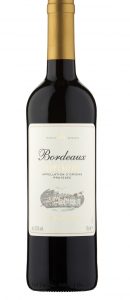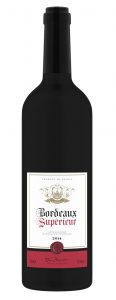Talk of Bordeaux reds and wallets start to shudder, but it is not all about the region’s costly superstars.
For sure, a handful of producers create spectacular wines of great complexity and longevity and with price labels to match.
However, there are around 5000 different estates in the region with most of them small and often producing wine that is far from expensive.
The region has over 30 appellations but over half of its output is in the modest Bordeaux AOC and Bordeaux Superieur AOC categories.
Finding those that excel at everyday prices, though, is not easy.
Some are too lean or too savoury or otherwise struggle to fit what today’s typical drinkers are seeking.
So, I collected a number of “High Street” examples of basic red Bordeaux and compared them.
Here is the result – which I hope you find helpful.
The images and hyperlinks provided should help you to find them in crowded displays.
First some context
Although geology is relatively kind to Bordeaux producers, the weather is less generous.
Ripeness can, thus, be an issue and, despite careful blending activity, vintages do vary appreciably.
Elusive ripeness can mean that savoury factors are more prominent (graphite, tar and earthiness are common examples) and add leafy (slightly vegetal) aromas.
So, we cannot expect exclusively fruit-bomb constituents.
Indeed, the key seems to be balancing savouriness, tannin, acidity and (usually dark) fruit in proportions that make each discernible – but none overpowering.
Since there is well over twice as much merlot as cabernet sauvignon, we can expect that variety to predominate in blends at cheaper price points.
Merot ripens earlier (so less chance of underripe components) and brings the raspberry, red cherry and plum flavours that are currently popular.
And the classification.
For consistency, all the group tried were in the Bordeaux Supérieur category.
This is the second level up the region’s hierarchy (after Bordeaux AOC).
It imposes specific controls on vine density, yields, alcohol level and aging requirement that do not all apply to Bordeaux AOC wines.
So, what were my top choices?
On the lighter side
2021 Des Tourelles Bordeaux Supérieur (£7.50 at Tesco and 12.5% abv):

This was the runner-up and is the product of the long standing relationship Tesco have forged with Yvon Mau – one of the region’s big players.
Medium bodied and nicely smooth, the wine contains lingering blackcurrant, plum and black cherry flavours.
Its supporting features include floral aromas, limited tannin and sharp acidity with menthol and aniseed touches.
My top choice.
2021 Bordeaux Supérieur (£5.99 at Lidl and 13%):

Ironically, the one that met my criteria best was also the cheapest, and represents tremendous value for money.
Almost black in colour and full, this has a centrepiece of attractive damson, loganberry and pomegranate flavours.
These are supplemented by balanced acidity, mild tannin and sweet edges with hints of mint, chocolate and tobacco.
And one I sampled earlier.
2021 Best Bordeaux Supérieur (£8.75 at Morrisons and 13%):

This was not part of this comparative tasting (because I had tasted it a few days earlier) but also impresses.
It is slightly lighter than the Lidl option but will win friends with its excellent acidity/tannin balance.
With leafy aromas and just the right acidic support, it has medium bodied cherry, bramble and plum flavours embellished by gentle tannin and suggestions of clove, cola and herbs.
My next post (on Monday) contains terrific recommendations of Top Tips for you in the weekly feature of the same name.









2 responses
On your recommendation I bought a couple of bottles at Lidl and was not disappointed. I lovely balanced wine which I thought was equally good without food. I can’t quite detect chocolate and mint, but that is probably my aging pallet. Went back and bought a case!!!
Thank you Richard – in what I think is your first contribution to the Comments section. The balance of that wine impressed me too but my observations about mint and chocolate were almost nine months ago and so those elements may have faded a bit in the interim – so it may not be your taste buds letting you down after all.